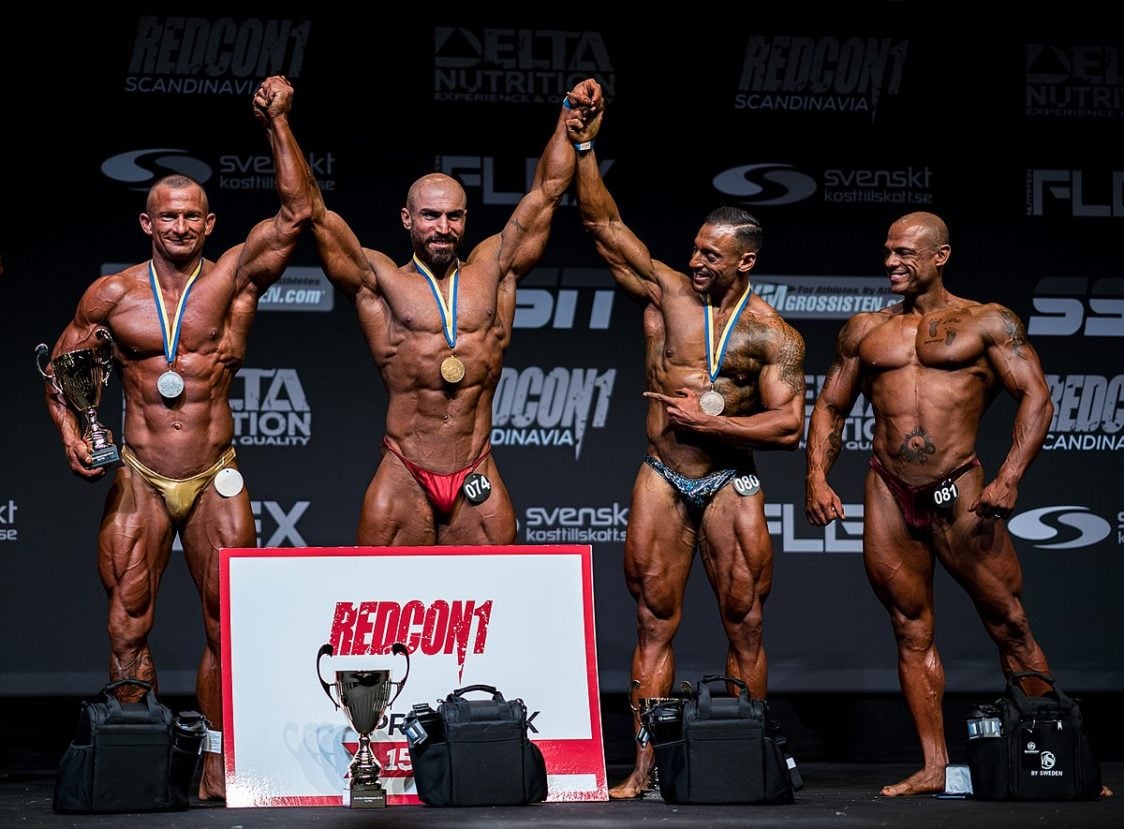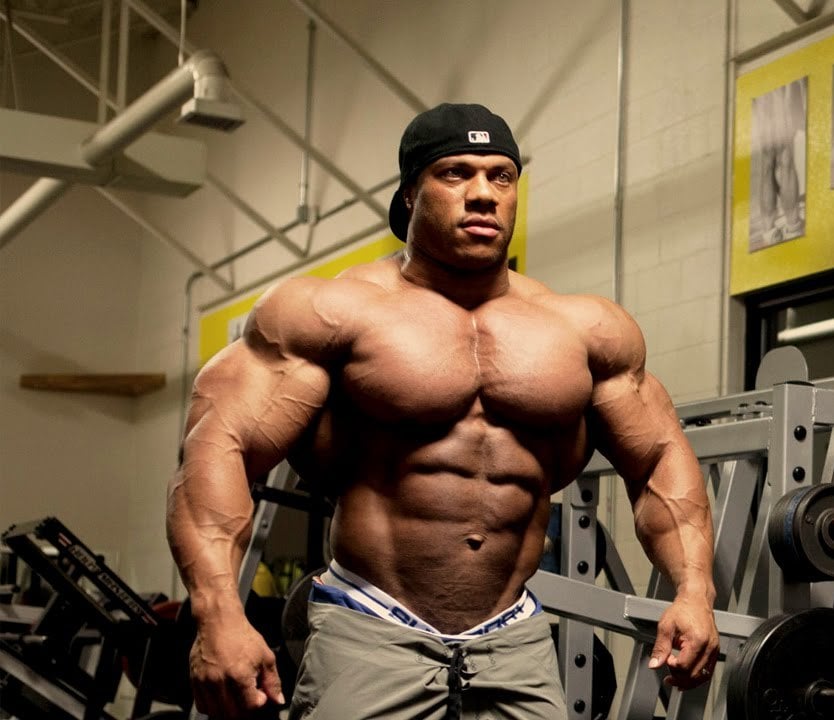Table of Contents
Pros are genetically programmed to be able to build far more muscle and carry far less body fat than the typical human. Even if that potential isn’t obvious before they start training, it rapidly reveals itself once they do. They respond to just about any kind of weight training with explosive muscle growth.
Some of these men have never experienced the common problems that normal lifters deal with every day. Still, and perhaps because of it, this makes them wonderful for inspiration, but it also means that the pros are not always a useful source of information—or a good role model for your workouts or nutrition.

https://commons.wikimedia.org/wiki/File:SBFF_SM_2019_Bodybuilding_-85_kg_Winners.jpg
For example, if most of us trained for 3-4 hours a day like the massive Maxx Charles, we would be overtrained and scrawny. And if most of us ate the piles and piles of junk food that Juan Morel does even as he nears a contest, we would be obese.
That’s not to say that there aren’t lessons to be learned from the pros, because there certainly are. Here are a few of them.
You might be interested in these products:
Dorian Yates: Less can be more

https://commons.wikimedia.org/wiki/File:Dorian_yates.png
For years, there was only one accepted way to train – high frequency and high volume. Arnold Schwarzenegger used to train every body part three times a week, and even today, it’s common to subject a body part to 20 or more working sets at any given workout.
But in the 1980s in Birmingham, England, a young aspiring bodybuilder named Dorian Yates was soaking up a different kind of wisdom from the likes of Arthur Jones and Mike Mentzer, both of whom had preached a training style that cut volume back dramatically and amped up recovery.
By the time Dorian won his first Mr. Olympia title in 1992, he had pared his workouts down to just four a week, hitting each body part once with only a handful of exercises at most, and in many cases just one all-out work set following warm-ups.
Dorian’s style of HIT (high-intensity training) was dubbed “Blood and Guts,” and it was a radical departure from the way his rivals trained.
The crux of his philosophy was to hammer the muscle with maximum effort with as little volume as possible, then allow it plenty of time to recuperate and grow.
Since Dorian’s physique set an entirely new standard in conditioned mass, bodybuilders all over the world emulated his Blood and Guts style. Various offshoots of it sprung up over the years and are still being used successfully to this day.
The lesson for you: Even if Dorian-style HIT is not your future, if you train with equal eyes to intensity and recovery, you owe part of your success to him.
Lee Haney: Stimulate, don’t annihilate

https://commons.wikimedia.org/wiki/File:Lee_Haney_Games_2017,_contestant_nr._171.jpg
Very few long-term trainers escape the iron game unscathed. Most in their 40s and 50s typically have a laundry list of injuries and pains they will gladly bore you with describing. These aren’t even champions with fancy titles, but just average gym rats who may or may not have been on stage a time or two.
Yet at 56 years old, eight-time Mr. Olympia Lee Haney is pain-free and has never suffered a training injury. How is that possible? Lee’s catchphrase was “Stimulate, don’t annihilate.” Well, he lived by that motto in the gym.
Despite being the largest Mr. Olympia ever seen at that time, Haney was adamant that bodybuilders should not train like powerlifters. He was always more concerned about quality muscle contractions and a powerful mind-muscle connection than he was about how much weight he used.
As one example, Lee had the greatest back development in the sport during his reign in the 1980s. Yet on barbell rows, he wasn’t heaving up 180-220 kg; it was more like 100-120 kg with perfect form. For dumbbell rows, Lee rarely went any heavier than 35 kg. Many of you reading this go much heavier on one or both of those basic back builders, but you probably have far less development to show for it than “TotaLee Awesome” did in his prime.
The lesson for you: It’s really not about the weight; it’s all about stimulating the muscle. And should you insist on focusing on mega-heavy weights for years and years, rest assured you will pay for it in pain for the rest of your days.
Ronnie Coleman: If it ain’t broke, don’t fix it
On one hand, Ronnie is a prime example of someone paying the aforementioned toll from his years of powerlifting-level weights. But that and “light weight!” definitely aren’t the only things we should remember about this eight-time Mr. Olympia.

https://commons.wikimedia.org/wiki/File:Ronnie_Coleman_8_x_Mr_Olympia_-_2009_-_2.png
Throughout the 17 years Ronnie competed, his training program remained virtually unchanged. His split was the same, and he did the same workouts with the same exercises week after week, year after year. Some tried to convince him to switch things up and try other methods, but Ronnie saw no reason to do so. In his prime, nobody could beat Ronnie.
The lesson for you: Many lifters are constantly changing up their workouts in a desperate search for the perfect routine. But they never stick with any routine long enough to even know if it was delivering substantial results or not. So keep doing what you’re doing if it works. Once it doesn’t, then and only then should you abandon it.
Jay Cutler: Find the form that works best for you
We always hear that strict form is best. But the truth of the matter is that “perfect” isn’t the same for everyone in every exercise. Sometimes, you really do have to adjust your form on a given exercise in order to feel the target muscle working at its fullest capacity. Sometimes, that means that your form may look less than ideal to the outside observer.
Four-time Mr. Olympia Jay Cutler acknowledges that his form often appears sloppy, but he’s found, through trial and error, that it gives him the best contractions. But here’s the catch: Jay has never been a big weight-pusher. No one should be using bad form and sacrificing feeling in the muscle simply for the sake of being able to handle heavier weight.
The lesson for you: You must find your own way in the gym. Textbook form will work best much of the time, but don’t be afraid to think outside the box and depart from it on occasion if it gives you better results.
Branch Warren: Injuries are only setbacks
Few people have dealt with as many muscle tears as Branch Warren. He has torn a biceps, both triceps, and won his second Arnold Classic title just seven months after fully tearing his legendary quadriceps. None of those injuries stopped Branch.
Lift heavy enough for long enough, and you might have problems and pain in your shoulders, knees, elbows, and lower back, even if you never officially tear a muscle. No matter the injury, the question is the same: Do you quit? A lot of people do just that.
Others simply get the treatment they need to keep going. That may involve surgery, chiropractic treatment, physical therapy, or just deep-tissue massage. It takes time to heal injuries and regain lost size and strength. Many people don’t have the patience, so they just stop training and go back to being a “regular person.” Branch sure as hell wasn’t about to do that, and neither should you.
The lesson for you: If you truly love training and improving your physique, there’s always a way forward. Injuries are setbacks, but they can also set you up for an inspiring comeback if you refuse to give up.
Kai Greene: Believe in yourself
Kai Greene was never supposed to succeed in life. He never knew his father, and his mother gave him up at an early age to be raised by the state of New York. Kai grew up in Brooklyn amid crushing poverty, drugs, gangs, and hopelessness. It was bodybuilding that gave him a purpose and a direction in life as a teenager, and he pursued that dream with all of his heart.
Still, many people discouraged him along the way. A female personal trainer took him under her wing for a time, yet she told him not to even bother training calves because as an African-American, his would always be small and weak. For much of his early bodybuilding career, Kai was homeless, struggling to have enough food to eat and often sleeping in the back of the gym at night.

https://commons.wikimedia.org/wiki/File:Kai_Greene_IFBB_2009_Australia_1.jpg
But through it all, Kai believed he could be one of the greats if he just kept working harder and harder. Sure enough, he is now a three-time Arnold Classic champion and a three-time Mr. Olympia runner-up. Had he listened to the negative voices on the street and in his head, chances are he might be dead or in jail today instead of one of the most popular bodybuilders of this generation.
The lesson for you: The world may tell you to stop. The world is wrong.
Dexter Jackson: Humble yourself and keep growing
A few years ago, Dexter Jackson seemed to be gradually winding down a stellar career. He had a Mr. Olympia title and three Arnold Classic titles to his credit, but he was over 40 years old and starting to fade. Oh well, he had a great run!
But Dexter didn’t feel he was ready to ride off into the sunset just yet. Knowing that what he was doing no longer seemed to be producing the same results, he humbled himself and sought out people who could get him back on track. He hired George Farah as his nutrition coach and began making the trek out from his native Florida to Venice Beach to train under Charles Glass. Dexter knew he hadn’t really been pushing himself very hard in the gym for a while, and Glass was just the man to do that for him.
Today, Dexter holds the record for the most Arnold Classic wins with five, and needs just one more contest win to break the all-time record of 25 pro wins held by Ronnie Coleman. Had Dexter been too proud to seek out expert guidance, he admits he would have most likely retired a few years ago.
The lesson for you: We may be less developed and accomplished than Dexter, but like him, we can humble ourselves, learn from the best, and keep improving.
The day you think you know it all in this game, you’re all done!
Phil Heath: There’s no substitute for victory
It can be easy to overlook Phil Heath. He hasn’t won as many titles as some of the men on this list (though that may change), and every year, it seems that as he walks away with the title at the Olympia, there’s a small chorus of voices saying that one of the runners-up got “robbed.” Plus, his training is anything but dramatic. It’s methodical, quiet, and nothing that screams “hardcore.”

https://commons.wikimedia.org/wiki/File:Philheath.jpg
But guess what? It works. Year after year, “The Gift” is the one left holding the trophy. He could listen to the criticisms and let his ego take over. He doesn’t. He just does one thing: win.
The lesson for you: There’s a time for fun and drama, and there’s a time to set your sites on an ambitious goal—a job, a partner, an accomplishment—and do what is necessary to make it happen. When that time comes, put your ego aside, forget about what is cool or hardcore, and just do the work!
What do you think about these greats of the bodybuilding world? Who is the greatest inspiration for you from this list? Let us know in the comments, and if you liked the article, support it by sharing.
[1] Bodybuilding – https://www.bodybuilding.com/

Add a comment